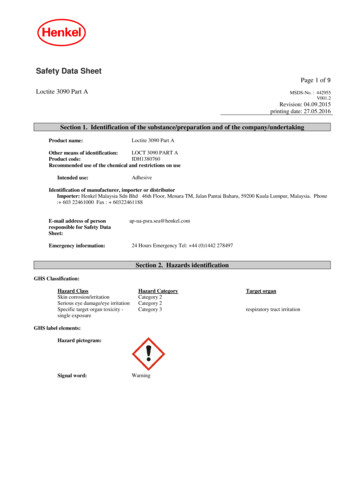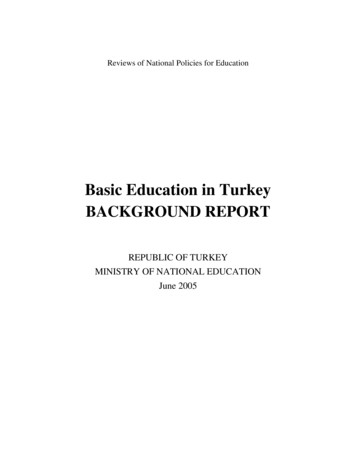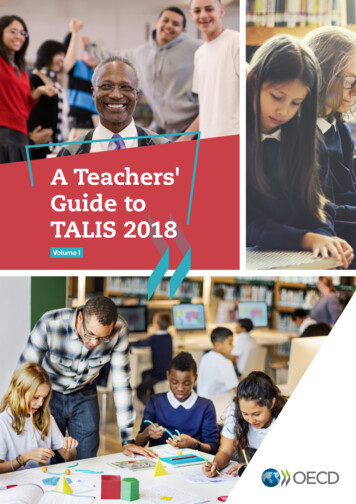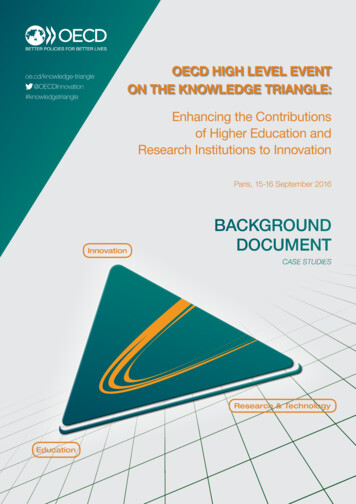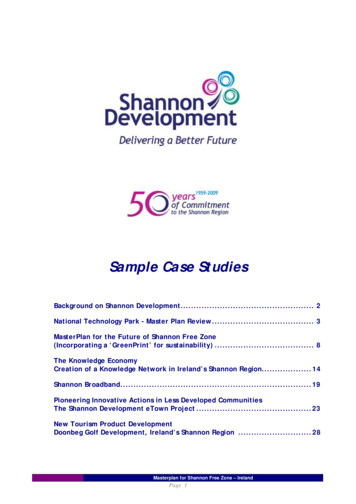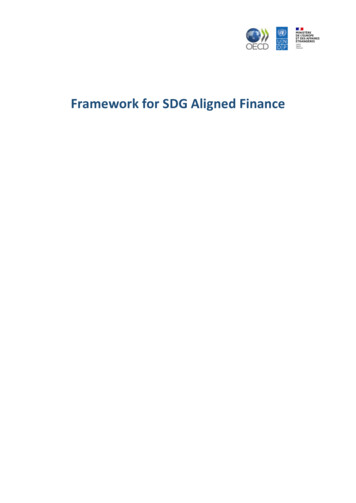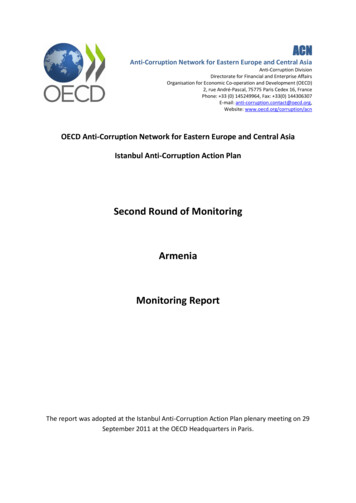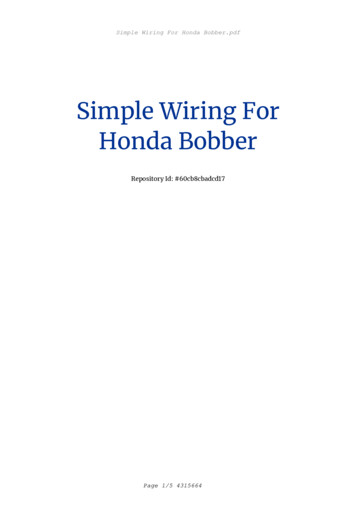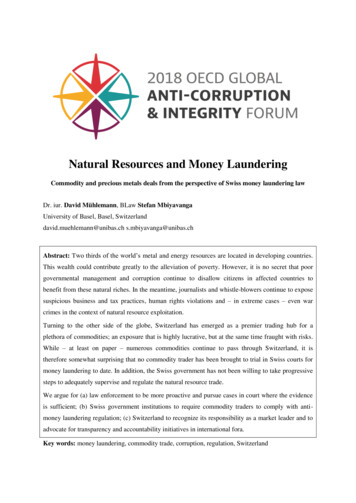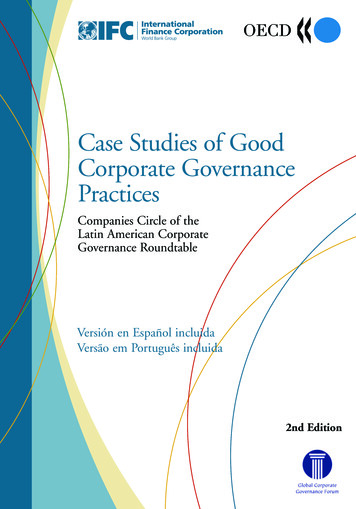
Transcription
Case Studies of GoodCorporate GovernancePracticesCompanies Circle of theLatin American CorporateGovernance RoundtableVersión en Español incluidaVersão em Português incluida2nd Edition
Copyright 2006 International Finance Corporation2121 Pennsylvania Ave. NW, Washington, DC 20433United States of AmericaA Member of the World Bank GroupThe findings, interpretations and conclusions expressed in this publication should notbe attributed in any manner to the International Finance Corporation (IFC), Organisationfor Economic Co-operation and Development (OECD) and their affiliated organizations,or members of their Boards of Directors or the countries they represent. IFC and OECDdo not guarantee the accuracy of the data included in this publication and accept no responsibility for any consequences of their use. The information on companies, prepared by themembers of the Companies Circle of the Latin American Corporate GovernanceRoundtable, reflects such companies’ own management’s and the board of directors’ view ofthe motivations, challenges, solutions and rewards for devising and putting in place bettergovernance rules and practices.The material in this work is protected by copyright. Copying and/or transmitting portions or all of this work may be a violation of applicable law. IFC and OECD encouragedissemination of this publication and hereby grant permission to the user of this work tocopy portions of it for the user’s personal, noncommercial use, without any right to resell,redistribute, or create derivative works here from. Any other copying or use of this workrequires the express written permission of IFC.
Case Studies of GoodCorporate GovernancePracticesCompanies Circle of the Latin AmericanCorporate Governance Roundtable2nd Edition
International Finance Corporation (IFC)The International Finance Corporation (IFC) is part of the World Bank Group andwas established in 1956 to encourage private sector-led growth in developing countries. It does this by financing private sector projects, helping companies mobilizefinancing in international markets, and providing advisory services and technical assistance to companies and governments. IFC’s practical experience with structuringinvestments, appraising potential investees and nominating corporate directors allowsit to put corporate governance principles into action. IFC’s focus on good corporategovernance practices in client companies helps it both to manage risk and to add valueto firms in emerging markets.Organisation of Economic Co-operation and Development (OECD)The Organisation of Economic Co-operation and Development (OECD) is aunique forum where the governments of 30 democracies work together to address theeconomic, social and environmental challenges of globalisation, in close co-operationwith many other economies. One of these challenges is corporate governance, a topicon which the OECD has developed internationally agreed Principles of CorporateGovernance, which have served as a basis for regional policy dialogue programmesthroughout the world. The Latin American Roundtable on Corporate Governance,which meets annually, is one such initiative, organized by the OECD in partnershipwith the IFC/World Bank Group and with the support of the Global CorporateGovernance Forum. In this way, the OECD provides a setting where governments andother stakeholders can compare experience, seek answers to common problems, identify good practice and work to co-ordinate domestic and international policies.Global Corporate Governance Forum (GCGF)Co-founded by the World Bank Group and the Organisation for Economic Cooperation and Development, the Global Corporate Governance Forum (GCGF) is anadvocate, a supporter, and a disseminator of high standards and practices of corporategovernance in developing countries and transition economies. Through its activities,the Forum actively supports regional and local initiatives that address corporate governance by leveraging institutional support for reforms and initiatives that build localcapacity and by making available technical and advisory assistance drawn from its widenetwork of international and private sector expertise. The Forum's donors include theInternational Finance Corporation, and the governments of Canada, France,Luxembourg, Norway, Sweden and Switzerland.
ContentsIntroductionAtlas Eléctrica1Buenaventura8Cementos Argos14Companhia de Concessões Rodoviárias (CCR)CPFL EnergiaEmbraer30Ferreyros3824Interconexión Eléctrica S.A. E.S.P. 8
IntroductionThis second fully revised edition of “Case Studies of Good Corporate GovernancePractices” presents the experiences of a set of leading companies in Latin America inreforming and improving how their firms are governed, and the results these changeshave achieved. The descriptions of the corporate governance improvements carried outat these companies were prepared with the direct support of the eight founding membersof the Companies Circle of the Latin American Corporate Governance Roundtable, as wellas five new members who joined the Circle in 2006. Each chapter’s contents reflect theviews of one company’s management and directors of the motivations, challenges, solutions and rewards for devising and putting in place better governance rules and practices.Informing all these accounts is a depth and diversity of experience not in the theoryof corporate governance, but rather in the practical application of the goals of transparency and disclosure, accountability, respect for the rights of shareholders and equitabletreatment of all stakeholders laid out in the OECD Principles of Corporate Governance andreflected in the recommendations of the Roundtable’s White Paper on CorporateGovernance in Latin America.The cases included herein are presented under the responsibility of the respectivemembers of the Circle. They speak for themselves. The impetus to begin to undertakechanges for some firms involved mainly internal considerations – to reconcile potentially divergent family or shareholder group interests, or to provide better incentives to managers, for example. Financial market considerations – the desire to attract new investorsor access new sources of outside capital – provided the principal motivation for otherfirms. However, when the varied experiences of the companies are considered together itis hard for the reader not to draw at least a few general conclusions:n While the principles of good governance may be fundamentally the same for allcompanies, there is great scope for creativity and innovation in applying suchprinciples to the specific circumstances facing individual firms. — THE CHALLENGE OF IMPLEMENTATION IS FOR EACH COMPANY TO FINDTHE PATH AND SOLUTIONS THAT FIT ITS CIRCUMSTANCES;n The commitment of managers and controlling shareholders is a sine qua non ofany sustained program of improvement in a company’s governance. — THEFIRM MUST HAVE STRONG INTERNAL CORPORATE GOVERNANCE CHAMPIONS;n To be fully successful, a corporate governance program must effectively communicate to stakeholders the unshakeable commitment of the firm, its management and controllers to the goals of corporate governance. — MARKETCREDIBILITY IS ESSENTIAL;
n The rewards of initial, narrowly-focused efforts can generate sustainablemomentum for more comprehensive efforts and a virtuous circle of adoption ofbetter practices. — GOOD CORPORATE GOVERNANCE IS A JOURNEY, NOT A DESTINATION; andn The experiences of Companies Circle members demonstrate the contributiongood governance can make to operational performance and access to / cost ofcapital. — IMPROVING GOVERNANCE YIELDS POSITIVE REALRETURNS.The chapters relating to the experiences of the founding members of the CompaniesCircle (Buenaventura, Cementos Argos, CCR, CPFL Energia, Natura, NET, Suzano andUltrapar) have been expanded and fully updated for this second edition. Earlier Englishlanguage versions of the chapters covering the Circle’s newest members (Atlas Eléctrica,Embraer, Ferreyros, ISA and Marcopolo) were prepared for and distributed at theSeventh Meeting of the Latin American Corporate Governance Roundtable, held inBuenos Aires in June 2006. All versions of the cases, and the other public documents ofthe Companies Circle, are available through the websites of the OECD Corporate AffairsDivision (www.oecd.org/daf/corporate-affairs/roundtables) and the IFC/World BankCorporate Governance Department (www.ifc.org/corporategovernance).As in the case of the first edition, the objective of the Companies Circle in publishing this book is to share with the broader community of Latin American firms practicalsolutions to the corporate governance challenges facing companies in the region. Wethank the members for their contribution to the Roundtable, and commend them fortheir work to demonstrate the business case for corporate governance to companiesthroughout Latin America and beyond.On behalf of the Roundtable, we would like to express our gratitude to the executivesand staff of each of the members of the Companies Circle who contributed in the preparation of the cases presented in this book. And, on behalf of the Companies Circle andourselves, we would also like to express our collective thanks to Ms. Sandra Guerra, whohas served with dedication and professionalism as coordinator of the Circle since itsinception.We look forward to continuing to work with the Companies Circle as it engages infurther efforts to identify and promote good company practices for implementing bettercorporate governance in Latin America.Mike LubranoHead, Investor & Corporate PracticeCorporate Governance DepartmentInternational Finance CorporationDaniel BlumePrincipal AdministratorCorporate Affairs DivisionOrganisation for EconomicCo-operation and Development
Atlas EléctricaAtlas Eléctrica (Atlas) was founded in a small shack in 1961 and, by 1976, grew to bethe first listed company to issue shares on Costa Rica’s stock exchange, the BolsaNacional de Valores (BNV). The founders of the company knew that this new listingopportunity would allow them to fund and help sustain Atlas’s growth potential. Thisstill holds true today. Market capitalization of Atlas at the end of September 2005 wasUS 17.2 million down 11.8% from US 19.5 million as of 30 September 2004.Atlas Eléctrica S.A. is the holding company of a manufacturing enterprise basedin Costa Rica with sales subsidiaries in Central America and the Dominican Republic.Atlas currently produces household refrigerators and stoves under its own brandnames of Atlas and Cetron. The company also manufactures on behalf of other private brands, such as Sunbeam and Nedoca, and previously manufactured under thebrand names White Westinghouse, Kelvinator, Frigidaire and Blue Point.Atlas’s sales in Central America, Mexico, United States, Jamaica, Puerto Rico andother Caribbean islands will yield estimated combined total annual revenue for fiscalyear 2006 of US 100 million. Atlas is the main player in the Central Americanregion with over 50% market share, competing head to head with products from Asiaand the Americas. Recently, Atlas had several product models that were certifiedaccording to US and Canadian standards. This has opened up export market potential for Atlas, on which it hopes to capitalize in the next few years, especially in lightof recently concluded free trade agreements in the region. Export market expansionis part of the company’s strategic growth plan and already accounts for the bulk of thecompany’s 28.5% sales increase in 2005, compared to the previous year.The main attributes that have allowed the company to succeed have been:n Years nurturing a brand image based on quality and excellent post-consumerservice; andn Creating value-products with tasteful designs accessible to the pocketbooksof the targeted clients.Case Studies1
Atlas’s current ownership structure is presented in the table below.Atlas has 1,432 employees as of August 2006.Atlas’s share price was Costa Rican Colones 18.28 on 30 September 2004 but fellto Costa Rican Colones 17.50 as of 30 September 2005. The company’s shares areincluded in the BNV stock index.It should be noted that the original founders currently do not have control of thecompany. Also, there are no institutional investor shareholders, and the free float ofshares is 3.9%. No one group holds control of the company. Control is establishedby the concurrence of several groups at the Annual General Meetings, and decisionsare made by the majority of votes present at the Meeting. Minority shareholders ofthe company are not provided with tag-along rights. However, local regulation doesestablish an obligation for a public offer, if a certain threshold percentage of shares aresought to be purchased. In such applicable cases, all shareholders will then haveaccess to a uniform offer price per share.Responsibilities of the Board and ManagementSince the mid 1980s, the Board of Directors has seen the benefits of having independent directors, including their fresh ideas and new approaches to the company. Of thecurrent seven Board members, four are independent. The Chairman of the Board doesnot have any CEO responsibilities. His only means of influencing management arethrough the Compensation and the Audit committees and at the monthly Board meetings where financial results, budgets and strategy are analyzed and approved. Key senior managers are chosen based on professional and merit criteria.Remuneration of the Board members is approved by the Board itself with the aimto be within reasonable limits when compared to other companies’ compensationpractices. There is remuneration paid for attending each Board meeting, normallyheld once per month. The executive compensation is fixed taking into considerationcomparative market information, reviewed and approved by the CompensationCommittee of the Board. Approximately 20% of the senior managers’ total compen-2Companies Circle
sation is linked to performance. To date, no stock options are granted to senior managers or Board members. The up-coming annual report will disclose the total amountdistributed to directors and managers on an aggregate basis.Atlas has two Board committees:n Audit Committee with 4 members—3 directors (one inside and two external directors—none being the Chairman of the Board) and a Fiscal Boardmember. A representative of the external auditors, a representative of theinternal auditor and the CEO also are invited to attend Audit Committeemeetings; andn Compensation Committee composed of 2 directors (one inside and oneexternal member—neither being the Chairman of the Board).The Costa Rican Controversy over Company Board RegulationIn 2004, new rulings were issued by the Consejo Nacional de Supervisión del SistemaFinanciero (CONASSIF), which is the supervisory body of financial institutions inCosta Rica. The rulings were designed to regulate the actions of audit firms and establish mandatory guidelines of corporate governance, in light of a securities scandal in thecountry and as an overflow of the grave financial scandals in the United States. One ofthe CONASSIF rulings called for the mandatory creation of Audit Committees oncompanies’ Boards of Directors. Such an Audit Committee already existed in Atlas, butamong its required tasks under the CONASSIF rulings was to review and approve thequarterly and annual financial results before subjecting them for review and finalapproval by the Board.One of the first tasks by this newly structured Audit Committee was to approve thehiring of an independent firm to help management put in place a stronger internal control environment. Pursuant to this, a project with this objective was initiated and sponsored by the CEO. The project’s management was delegated to an outside firm,Deloitte Touche Tohmatsu, and the company’s CFO.1 The end purpose of this projectwas to give additional assurances to the Chairman of the Board and the CEO that thefinancial information that goes out to the general public is free of material omissionsand that a strong internal controls system is in place. Both of them want to be able topersonally attest to that.The CONASSIF rulings left many listed companies unhappy over the way thisrecent regulatory action was carried out. The process of developing and adopting these1 At this moment, Atlas is making significant efforts to draft and disseminate numerous control policies and procedures throughout the company. The methodology being used in this effort is the model used in the InternationalOrganization for Standardization (ISO) 9000 certifications. ISO sets standards for quality management and assurance, and the company has already been certified in the production, selling and distribution processes, and now thesame methodology (though not the certification) is being used for the company’s adoption of good corporate governance procedures.Case Studies3
regulatory rulings ensued without full consultation with the private sector. The resultof this is that some articles promulgated under Costa Rican regulations are even harsher than the Sarbanes-Oxley Act in the United States. Naturally, the private sector reacted. Some companies immediately filed a suit, alleging jurisdictional and privacy violations. Others decided it was time to de-list. The Board members of Atlas believed thata fair settlement would come out of the court rulings, and the benefits of staying listedin the BNV outweigh any temporary inconveniences. Currently, some of the issuedCONASSIF rulings are suspended by the Constitutional Court, and the case is stillpending a final resolution. Some of those suspended rulings related to the AuditCommittee. The Atlas Board of Directors deemed it desirable to comply with the newformal requirements for the Audit Committee anyway, and have it function as thoughthe rulings were still in place, despite their suspension.Transparency is of the highest value to Atlas, and its practices are consistent with thisvalue. Every quarter the company must file its financial information, which is compiledaccording to International Financial Reporting Standards (IFRS). Once filed, Atlas’sfinancial information is placed in the public domain via the web page of theSuperintendencia General de Valores (SUGEVAL). The year-end audited financialinformation is also posted on the same network.Financial statements of Atlas are audited by the external audit firm KPMG PeatMarwick. The external auditors are accountable to the Audit Committee of the Board.Also, once a year, with quarterly updates, an external company qualifies Atlas from a riskperspective. The company’s chief of internal audit reports directly to the Audit Committee.Another Atlas initiative to highlight transparency has been the Board’s policy that allkey personnel of the company as well as the members of the Board of Directors, on anannual basis, have to sign and certify that they have read and understood the Code ofEthics of the company. This Code addresses topics like legal compliance, conflicts ofinterest and use of confidential information. At the current moment, a new version ofthe Code of Ethics is being reviewed and scheduled for implementation later this year.Overall, the responsibility to oversee corporate governance practices and undertakeany improvements at Atlas lay with the CEO and CFO.The “Golden Cage” Effect of the MarketplaceBecause of the limited number of companies whose shares have been issued in the BNV,the market has not had adequate liquidity, and this has in some way affected the shareprice of the majority of companies in the Costa Rican market. The main shareholdersof these companies do not on a regular basis make important transactions on the market. This hampers the stock exchange’s ability to convey the “true” price of listed companies, negatively affecting the companies’ market capitalization value.4Companies Circle
The above creates a downward spiral. It starts by deterring institutional investorsand the general public from investing in the local equity market, which creates a smaller number of BNV participants and decreases demand, thus lowering the price of thelisted shares. Ultimately, this has created what has been called a “Golden Cage” effect.The large shareholders, who are not active in the market, are sitting on net worth thatis, by financial analysts’ predictions, much higher than the “market price” of the smallquantity of stocks being transacted through the local stock exchange. In the absence ofother active buyers, however, the holders of smaller equity stakes will have to sell atwhatever price they can get in an illiquid market. In short, these artificially lower priceshurt mainly the small investors. This is the case of Atlas’s shares, where the small quantities of shares are sold as much as 25% below book value.An alternative to creating liquidity would exist if the companies could buy-backshares in the market, but they have not been able to do so because of rulings created bySUGEVAL severely limiting that possibility. Thus far, SUGEVAL has refused to repealits controversial rulings, claiming that moving away from those rulings could subject thecompanies to investigations for trying to manipulate the equity market. Even though theCámara de Emisores (the Chamber of Listed Companies) has tried to negotiate modifications to those rulings for the past four years, it has been an uphill battle to no avail.Both the CONASSIF and SUGEVAL rulings and the way changes to these regulations were made without constructive negotiations with the listed companies, shed lighton the local market credibility issues. These issues have damaged communications andrelations among the two sectors, namely the regulatory sector and the private sector(listed companies). Because of this reality, the BNV with the help of some listed companies, among them Atlas, has started three initiatives. The first is to develop andadhere to voluntary corporate governance guidelines (comply-or-explain), similar to theones in use in the United Kingdom and Hong Kong. If successful, this voluntary compliance approach could eventually replace the CONASSIF rulings under challenge inthe Constitutional Court. Second, an initiative to develop voluntary guidelines forinvestor relations programs is being undertaken to increase transparency of the market.The third initiative, also a first in Costa Rica, is a “market makers” mechanism usingAtlas’s shares. To be able to do this, three brokerage houses were brought on board fora three-month pilot plan, and were granted “safe harbor” provisions by SUGEVAL.The idea is to allow investors an alternative to be able to sell or buy Atlas’s shares anytime with these brokerage houses. Each brokerage house in the pilot plan has committed and guaranteed to the market that they will always have a certain number of sharesin their inventory that they would be willing to sell or otherwise buy. This eliminatesthe risk factor to the investors that is brought on by the uncertainty of not knowing ifthere will be a prospective buyer (seller) of Atlas’s shares. The results in the first twomonths have been a less volatile market price for the small amount of Atlas’s sharestraded, though still below book value.Case Studies5
Recent Results and Challenges AheadIn the last two years, the financial results of Atlas improved year-on-year. In particular,in 2005 the company had net income of Costa Rican Colones 1,218,337 thousands(US 2.8 million) which is an increase of 27.9% over the net income of Costa RicanColones 952,402 thousands (US 2.1 million) in 2004. Other financial results are asfollows:n Net operating revenues: 2004 - Costa Rican Colones 33,552,395 thousands / US 78.4 million; 2005 - Costa Rican Colones 43,116,143 thousands / US 92.2 million;n Net costs and expenses: 2004 - Costa Rican Colones 32,034,853 thousands / US 74.7 million; 2005 - Costa Rican Colones 41,435,894 thousands / US 88.7 million;n Net cash: 2004 - Costa Rican Colones 2,336,915 thousands / US 5.2 million; and 2005 - Costa Rican Colones 2,563,317 thousands / US 5.6 million.Since the year 2000, because of a US 10 million bond issue used to finance the purchase of a competing manufacturer in El Salvador, the company has been analyzed quarterly by a local independent risk analysis firm that has always given Atlas a triple AAAqualification, their highest. Atlas has earned these high marks by consistently demonstrating to its bondholders and others its superior capacity for paying capital and interest on the agreed terms.Atlas understands that in order to grow further, it will need to tap into other financial markets. Transparency has come naturally to the company, and doing this task evenbetter is in line with the company’s strategic plan. The new audit-related regulations arepart of the current global experience, which the company embraces. Consistent withthis global outlook, Atlas is also increasingly taking on the export market, since morethan 80% of its sales are already being done successfully abroad. In taking on exports,Atlas is also embracing corporate social responsibility both at home and in new foreignmarkets, already garnering superior ratings from local and regional indices on its sustainable and socially-responsible practices.Atlas aims to persuade current and future shareholders of the value of the company.Atlas also aims to demonstrate that it is a company that is here to stay for many, manymore years, competing in a globalized market, like it has done in the past, but with better intangible assets, creditworthiness, transparency and good corporate governancepractices in its future. In terms of governance improvements, Atlas seeks to further6Companies Circle
improve its internal control procedures to address the requirements of the regulatoryagencies and the Board of Directors that the financial information being published isfree of material omissions, but also as a means to assure itself and the shareholders thatthe actions of the management are done according to approved policies. The guidelines for this project are those defined by COSO for internal control procedures andpractices.Case Studies7
BuenaventuraGrowth is more than merely one part of the mission and vision of Buenaventura—theleading mining company in Peru and one of the largest gold and silver producers in theworld. It is the company’s daily mantra.Today, Buenaventura operates four important mines in Peru (Orcopampa,Uchucchacua, Antapite and Colquijirca) and has an aggressive explorations program.The company owns 43.65% of Minera Yanacocha S.R.L., one of the most importantgold producers in the world, and an 18.5% ownership in Sociedad Minera Cerro Verde,an important Peruvian copper company. The company has 2,127 employees.Operating in a capital- and labor-intensive industry, and in a geographic environment not as welcoming to investments as it should be, the company recognizes that itmust be persistent to maintain the degree of success it has achieved over the years.Joint ventures, offerings through the Lima Stock Exchange, and an AmericanDepositary Receipts (ADR) issuance on the New York Stock Exchange (NYSE) were allmeans to achieve the company’s goal of continued growth. But when it came to creating long-term sustainable shareholder value, there was only one way to do it: by enhancing corporate governance practices.The Roots of the Need for GovernanceBuenaventura has focused on exploration and acquisitions, both on its own andthrough joint ventures, since its founding in 1953. For Buenaventura, conductingbusiness responsibly and effectively is part of its strategy to increase shareholder value.Buenaventura suffered several years of losses that, ultimately, led to a high level ofdebt amid Peru’s weak economic environment during the 1980s. In the early 1990s,however, Peru emerged into a period of greater stability, allowing Buenaventura toplan for a more promising future.When the company decided to invest in Yanacocha, now a world-class golddeposit, Buenaventura faced high-cost exploration and development investments.Convinced that the market pays for good corporate governance practices,Buenaventura chose to cancel its debt with the proceeds of an initial public offering(IPO) of ADRs on the NYSE in 1996. This IPO permitted the company to raiseapproximately US 150 million.8Companies Circle
The decision reflected Buenaventura’s Board of Directors’ and management’s commitment to comply with United States Securities & Exchange Commission’s (SEC)regulations. Prior to the IPO, the company took several critical steps toward improving its governance:n Revamped its Board of Directors, introducing independent members andestablishing Board committees;n Implemented an Ethics Code;n Created a Disclosure Committee; andn Eliminated its dual class share structure and converted all its shares into a single class with equal voting rights.Before the IPO of ADRs on the NYSE in 1996, the founders, the Benavides family, owned 42% of the company. Today, the family owns 27%. Apart from theBenavides family, there are several institutional shareholders, pension funds, industrial companies and banks invested in Buenaventura. The current ownership structureis presented below.Today, the company’s free float of equity is 65%. Fifty-five percent of the totaloutstanding shares are held in the ADR program. Buenaventura’s shares are listed andtraded on the Lima Stock Exchange, and the company’s ADRs trade on the NYSE.Buenaventura’s shares are not included in any stock index.Corporate Governance StepsBuenaventura has implemented a comprehensive set of rules to ensure good govenance. The reforms were inspired by the recommendations of major internationalorganizations, such as the OECD, the Global Corporate Governance Forum and theWorld Bank/IFC.For example, the decision to convert all shares into a single cla
Case Studies 1 Atlas Eléctrica Atlas Eléctrica (Atlas) was founded in a small shack in 1961 and, by 1976, grew to be the first listed company to issue shares on Costa Rica’s stock exchange, the Bolsa Nacional de Valores (BNV

